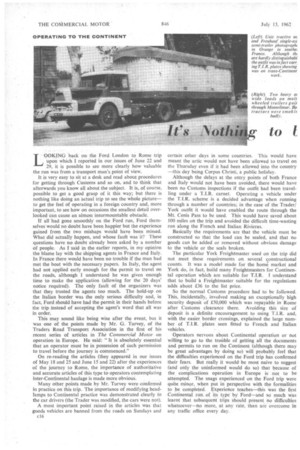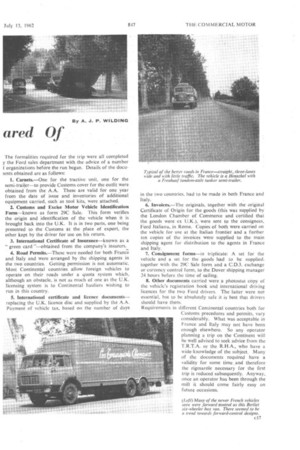to
Page 46

Page 47

If you've noticed an error in this article please click here to report it so we can fix it.
ared Of
By A. J. P. WILDING
LOOKING back on the Ford London to Rome trip upon which I reported in our issues of June 22 and 29, it is possible to see more clearly how valuable the run was from a transport man's point of view.
It is very easy to sit at a desk and read about procedures for getting through Customs and so on, and to think that afterwards you know all about the subject. It is, of course, possible to get a good grasp of it this way; but there is nothing like doing an actual trip to see the whole picture— to get the feel of operating in a foreign country and, more important, to see how on occasions the smallest detail overlooked can cause an almost insurmountable obstacle.
If all had gone smoothly on the Ford run, Ford themselves would no doubt have been happier but the experience gained from the two mishaps would have been missed. What did actually happen, and whose fault was it? These questions have no doubt already been asked by a number of people. As I said in the earlier reports, in my opinion the blame lay with the shipping agents in France and Italy. In France there would have been no trouble if the man had met the boat with the necessary papers. In Italy, the agent had not applied early enough for the permit to travel on the roads, although I understand he was given enough time to make the application (allowing for the 20 days' notice required). The only fault of the organizers was that they trusted the agents too much. The hold-up on the Italian border was the only serious difficulty and, in fact, Ford should have had the permit in their hands before the trip instead of accepting the agent's word that all was in order.
This may sound like being wise after the event, but it was one of the points made by Mr. G. Turvey, of the Traders Road Transport Association in the first of his recent series of articles in The Commercial Motor on operation in Europe. He said: "It is absolutely essential that an operator must be in possession of such permission to travel before the journey is commenced."
On re-reading the articles (they appeared in our issues of May 18 and 25 and June 15 and 22) after the experiences of the journey to Rome, the importance of authoritative and accurate articles of this type to operators contemplating inter-Continental haulage is made more obvious.
Many other points made by Mr. Turvey were confirmed in practice on this trip. The importance of modifying headlamps to Continental practice was demonstrated clearly to the car drivers (the Trader was modified, the cars were not).
A most important point raised in the articles was that goods vehicles are banned from the roads on Sundays and c16 certain other days in some countries. This would have meant the artic would not have been allowed to travel on the Thursday even if it had been allowed into the country —this day being Corpus Christi, a public holiday.
Although the delays at the entry points of both France and Italy would not have been avoided, there would have been no Customs inspections if the outfit had been travelling under a T.I.R. carnet. Operating a vehicle under the T.I.R. scheme is a decided advantage when running through a number of countries; in the case of the Trader/ York outfit it would have enabled the route through the Mt. Cenis Pass to be used. This would have saved about 100 miles on the trip and avoided the difficult time-wasting run along the French and Italian Rivieras.
Basically the requirements are that the vehicle must be constructed so that the toad can be sealed, and that no goods can be added or removed without obvious damage to the vehicle or the seals broken.
The particular York Freightrnaster used on the trip did not meet these requirements on several constructional counts. It was a model made for the home market and York do, in fact, build many Freightmasters for Continental operation which are suitable for T.I.R. I understand that to build a Freightmaster suitable for the regulations adds about £36 to the list price.
So the normal Customs procedure had to be followed. This, incidentally, involved making an exceptionally high security deposit of £50,000 which was repayable in Rome after Customs clearance there. Avoiding this size of deposit is a definite encouragement to using T.I.R. and, with the easier border crossings, explained the large number of T.I.R. plates seen fitted to French and Italian vehicles.
Operators nervous about Continental operation or not willing to go to the trouble of getting all the documents and permits to run on the Continent (although there may be great advantages by doing so) will probably feel that the difficulties experienced on the Ford trip has confirmed their fears. But really it would be most naive to suggest (and only the uninformed would do so) that because of the complications operation in Europe is not to be attempted. The snags experienced on the Ford trip were quite minor, when put in perspective with the formalities to be completed. Experience teaches—this was the first Continental run, of its type by Ford—and so much Was learnt that subsequent trips should present no difficulties whatsoever—no more, at any rate, than are overcome in any traffic office every day.
The formalities required for the trip were all completed y the Ford sales department with the advice of a number f organizations before the run began. Details of the docutents obtained are as follows: I. Carnets.—One for the tractive unit, one for the semi-trailer—to provide Customs cover for the outfit were obtained from the A.A. These are valid for one year from the date of issue and inventories of additional equipment carried, such as tool kits, were attached.
2. Customs and Excise Motor Vehicle Identification Form—known as form 29C Sale. This form verifies the origin and identification of the vehicle when it is brought back into the U.K. It is in two parts, one being presented to the Customs at the place of export, the other kept by the driver for use on his return.
3. International Certificate of Insurance—known as a green card "—obtained from the company's insurers.
4. Road Permits.—These were needed for both France and Italy and were arranged by the shipping agents in the two countries. Getting permission is not automatic. Most Continental countries allow foreign vehicles to operate on their roads under a quota system which, although an obstacle, is not as much of one as the U.K. licensing system is to Continental hauliers wishing to run in this country.
5. International certificate and licence documents— replacing the U.K. licence disc and supplied by the A.A. Payment of vehicle tax, based on the number of days in the two countries, had to be made in both France and Italy.
6. Invoices.—The originals, together with the original Certificate of Origin for the goods (this was supplied by the London Chamber of Commerce and certified that the goods were ex U.K.), were sent to the consignees, Ford italiana, in Rome. Copies of both were carried on the vehicle for use at the Italian frontier and a further ten copies of the invoices were supplied to the main shipping agent for distribution to the agents in France and Italy.
7. Consignment forms—in triplicate: A set for the vehicle and a set for the goods had to be supplied, together with the 29C Sale form and a C.D.3. exchange or currency control form, to the Dover shipping manager 24 hours before the time of sailing.
8. Other documents carried were a photostat copy of the vehicle's registration book and international driving licences for the two Ford drivers. The latter were not essential, but to be absolutely safe it is: best that drivers should have them.
Requirements in different Continental countries both for Customs precedures and permits, vary considerably. What was acceptable in France and Italy may not have been enough elsewhere. So any operator planning a trip on the Continent will be well advised to seek advice from the T.R.T.A. or the R.H.A., who have a wide-knowledge of the subject. Many of the documents required have a validity for some time,and therefore the rigmarole necessary for the first trip is reduced subsequently. Anyway, once an operator has been through the mill it should come fairly easy on future occasions.












































































































